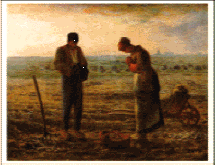


Part III -- Contributions of the Sons of Ham
Text: "And the sons of Noah that went forth of the ark were Shem and Ham and Japheth: and Ham is the father of Canaan. These are the three sons of Noah: and of them was the whole earth overspread." (Gen. 9:18,19) (See: Chapter 10)
"While the great contributions of Shem have mainly been in the field of religion, and the descendants of Japheth have centered around philosophy and science, the contributions of the sons of Ham have predominantly been in the field of technology." 1
"Hamites, it can be shown, have been in unexpected ways the world’s great innovators, though few people, except perhaps archeologists, ethnologists, and cultural anthropologists have been
aware of it. The acknowledgement of our own debt to them is long overdue." 2
The descendants of Ham developed banking, the postal system and navigation, 3 "The principles of banking passed from Babylonia to Greece and thence to ancient Italy and Rome." 4 After the dispersion at Babel, it was the Hamites who became the original explorers settling nearly every part of the world. 5
"The Hamites, in general, like the Canaanites of old, were a seafaring people and sooner arrived at civilization and the luxuries of life than their simpler, pastoral and agricultural brethren of the other two families. The first great empires of Assyria and Egypt were founded by them, and the republics of Sidon, Tyre and Carthage were early distinguished for their commerce." 6
They discovered the use of medicines and invented surgical practice.7 It is documented that South America performed brain surgery.
"Of African medical skill, Grantly Dick Read has pointed out ‘They had cures for diseases which modern science still finds difficult to heal." "What is absolutely certain," declares Robert Lowie, "is that our local anesthetics go back to the Peruvian Indians’ Coca leaves. Whence our Cocaine." 9
The first cultivation of the world’s basic food staples such as potatoes, beans, corn and cereals was dine by Hamites. 10 Herodotus, the reputed "father of History," wrote of Babylon, "Of all the countries that we now, there is no other so fruitful in grain." 11 Wheat and barley were first domesticated in that part of the world, and wheat still grows wild there. 12
In Genesis 2:8-15, Moses places Paradise, The Garden of God and the original home of man in Southern Babylonia. The ancient name for this district was Edin (Eden). 13
Agriculture in the form of large scale planting of the great meals such as wheat, oats, barley and rice seems to have begun in fertile regions of Egypt and western Asia. 14 In the Americas, the potato, the tomato, corn, tobacco and the manioc or tapioca plant were native and were cultivated by the Indians; 15 so was the aloe, the chili pepper, the pumpkin, cotton, the pineapple, the Jerusalem artichoke, cacao, and others. 16 Coffee came from Ethiopia. 17
Hamites were also the first to domesticate most animals. 18
In Egypt, sheep were driven across sown fields to trample the seed into the moist soil. 19 Although "The dog was man’s first conquest over the animal kingdom," 20 the ancient Egyptians early trained the ox to bear a yoke and to drag a plow. 21 The horse, however, was tamed by the Hittites. 22
It was the descendants of Ham who also developed the use of fabric for clothing including the arts of sewing and weaving. 23 In Egypt, the "land of Ham," linens were considered to be so fine and transparent as to merit the name of "woven air." 24 "Some of the garments associated with King Tutankhamen’s tomb have 220 threads to the inch compared with our common handkerchiefs of today which show only about 60-70 threads per inch." 25
In Babylonia, Hamites developed building tools and materials. 26 Since the alluvial soil provided abundance of clay, it was molded into bricks and baked in the sun. 27 Babylonia is believed to be the original bone of porcelain, and enameled bricks found there are unsurpassed by the best products of the present day. 28
Sumerians invented drinking straws, 29 and used naphtha gas for purposes of divination, and probably in furnaces for heating metals. 30
In ancient Egypt and Babylonia, there were blacksmiths, carpenters, stonecutters, workers in ivory, in silver, and in gold;
there were weavers, potters, and glass blowers. 31 "It is not surprising that we, having largely learned from Africa the basic techniques of iron working, should refer to our iron metal workers as Blacksmiths." 32 However, "The Hittites are credited with the first people to work iron." 33
Sumerians developed running water and an efficient sewer system.34 Egyptians built a pipe organ using water pressure 35 and the Parthians made batteries using pottery. 36
Who in our generation will deny the skill and ingenuity of Japanese technology? Yet the Japanese are Hamites. 37
The hammock was designed in New Guinea; 38 and when the Spanish discovered a self-acting water pump in the Hurari tribe in Colombia, So. America, they adopted it converting it into a bilge pump. 39
"In the first century A.D., the Chinese had discovered how to make paper." 40 Wooden block printing was invented in China about 600 A.D. 41 The Chinese later developed moveable type. 42 The Chinese constructed the earliest relief maps. 43 They pioneered in the inoculation against smallpox, 44 and were using the magnetic compass for navigation by 1100 A.D. 45 According to Melville Herskovits, Africans were using vaccines long before the white man adopted them. 46
The first iron clad battle ship was built by the Koreans in the 1500’s. It was called "Tortoise Boat" and was designed by Yi Soon Sin. It enabled the Koreans to gain a decisive naval victory over the Japanese. 47
Black powder, or gunpowder, was used by the Chinese in the 6th Century, 48 and when Marco Polo returned to Europe, his account of strange black stones the inhabitants of Cathay burned for heating purposes "...seemed fabulous to them since coal was unknown in Medieval Europe." 49
"It is said that in the reign of Emperor Ming, a man named Wing Dow invented a ‘device’ he called ‘looking-through-the walls’, whence it is claimed we now derive our word ‘window,’ a corruption of the inventor’s name.’ 50
Sunshades and folding umbrellas were designed in China and were not introduced into England for several centuries. The man who did so, nearly lost his life. 51
The sternpost rudder as well as canal locks are contributions made by China. 52
The Chinese used fingerprints for identification as early as 618 A.D. in the ‘Tang Dynasty;’ 53 and at a time when the Romans threw away cast iron as useless, 54 the Chinese as early as 150 B.C. were making cast iron stoves. 55
They invented water clocks, 56 and developed every form of airborne device including rockets, kites, gliders, balloons, parachutes, and early even made a toy helicopter. 57 "China enters first claim to the invention of the balloon --centuries before Europe knew it;" 58 and Lu Pan is said to have made a glider in the form of a magpie, from wood and bamboo, approximately 550 B.C. 59
China received only 3 items from the West: the force pump for liquids, the crankshaft, and the spring-powered clock. 60 Yet, the Chinese are Hamites, for Scripture says, "And Canaan begat...the Sinite." (Gen. 10:15,17} "It is significant that the Chinese people have always been identified by the prefix ‘Sino’—(e.g. Sino-Japanese War, Sinology, the study of Chinese history)" 61
Animal tales came from Ethiopia. In their book The Ila Speaking People of Northern Rhodesia, Edwin Smith and Andrew Dale point out that it was Lokman, who on account of his wisdom was released from slavery by his Greek captors, who, not knowing his real name, called him ‘Aesop’, a corruption of ’Aethiops.’ 62
The sons of Ham pioneered in the use of electricity, the internal combustion engine, the planning of cities, and the invention of tools... 63 Saws, squares and the lathe were Etruscan in origin, while the level came from Ethiopia, 64 and the wheel-barrow came from China. 65 The Persians invented the windmill. 66
The use of the arch, and the dome were in use long before the Romans, so was the use of concrete. 67
All lends meaning to the words of Solomon, "There is no new thing under the sun." (Eccles. 1:9}
Footnotes
1 Morris Henry. Genesis Record. Copyright 1976, Grand Rapids: Baker Book House. P. 243.
2 Arthur Custance. Noah’s Three Sons. Copyright 1975, Grand Rapids: Zondervan Publishing Company. P.156.
3 Morris, p.241 16 Custance. p. 167.
4 Hutton Webster. Early European History. Copyright 1924. Lincoln, Nebraska. p. 47.
5 Morris. p. 241. 17 Ibid. p. 199.
6 William Hales in A Commentary on the Old and New Testament by Adam Clark. Vol. I of 6 vols. Printed 1856 by Carleton and Porter, New York. p. 81.
7. Morris, p. 241. 18 Morris, p. 241.
8 Grantly Dick Read. No Time for Fear, as reviewed by W. A. Deacon in the Saturday Review of Books, "Globe and Mail"; Toronto, August 11, 1956, cited by Custance, p. 173.
9 Lowie Robert. An Introduction to Cultural Anthropology. Second Edition. Copyright 1940 by Farrar and Rhinehart. P.336, cited by Custance, p. 176.
10 Morris, p.241. 19 Webster, p. 245.
11 Webster, p. 22. 20 Ibid. p. 6.
12 Ibid. 21 Ibid.
13 Ibid. 22 Custance. P. 193.
14 Ibid. p.8. 23 Morris, p. 241.
15 Ibid. 24 Webster, p.45.
25 Custance, p. 181. 49 Ibid. p. 344.
26 Morris, p. 241. 50 Custance, p. 204.
27 Webster, p. 22. 51 Ibid. p. 202
28 Ibid. p. 45 52 Ibid. p. 203
29 Custance, p. 200 53 A. C. Haddon. The History of Anthropology
Copyright 1934, London: Watts, p.33. Cited by Custance, p. 213.
30. R. J. Forbes. A History of Technology. Vol. I Edited by Charles Singer, p. 251; and R. J. Forbes. Metallurgy in Antiquity. P.111. Cited by Custance, p. 203.
31 Webster, p. 45 54 Custance, p. 214
32 Custance, p. 201 55 Ibid. p. 205
33 T. Walter Wallbank; Alastair Taylor; Nels Bailky. Civilization: Past and Present. Copyright 1962. Chicago: Scott, Foresman and Co. p. 28.
34 Custance, p. 149 56 Ibid. p. 213
35 Ibid. p. 177 57 Ibid. p. 205
36 Willi Apel. Early History of the Organ, "Speculum", 23 (1948): pp. 191-216, cited by Custance, p. 202
37 Morris, p. 240.
58 Francis Miller. The World in the Air. Vol. 1 Copyright 1930, New York: Putnam’s Sons, p. 99. Cited by Custance p. 211.
38 Custance, p. 186
39 Ibid. 59 Ibid.
40 Wallbank, p. 340.
60 J. Needham. Science and Civilization in China. Vol. I Copyright 1954. Cambridge, p.241. Cited by Custance, p.206
41 Ibid.
42 Morris, p. 241. See: Wallbank, p. 340
43 Wallbank, p. 342 61 Morris, p. 256
44 Ibid. 62 Custance, p. 199
45 Ibid. 63 Ibid. p. 216
46 Melville Herskovits. Man and His Work. Copyright 1950, New York: Knopf. P.246, "Vaccines" cited by Custance, p. 202
47 Custance, p. 203 64 Ibid. p. 202
48 Wallbank, p. 342 65 Ibid. p. 205
66 Ibid. p. 215
67 Ibid. p. 202
68 Le Comte Du Nouy. Human Destiny. Copyright 1947. New York: Longmans Green, p. 139. Cited by Custance, p. 204.